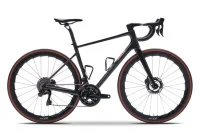How Faster Can Feel Slower
A version![]() of this article was originally
of this article was originally
published in Triathlete Magazine
My new bike feels slower than my old bike, but when I look at my times I am actually faster. How can this be?
Emily, e-mail
Dear Emily,
Inaccuracies in our perceptions are one reason why test rides are not always reliable indicators as to what bike we should get. The bike that feels the fastest might not always be the fastest. Here are some reasons why:
The Positioning Effect – The position you ride in can not only influence your comfort, but your speed. A better riding position might not feel faster in certain situations, but will allow you to ride more efficiently longer, while being less demanding on your body. A position that is too demanding might feel fast initially, but a more comfortable and efficient position that your body can hold longer will actually be faster.
Remember, for best results, always start your bike selection process by determining your ideal riding position and then using that information to help you select a bike that fits your position well. Matching the bike to the rider’s needs is a far more reliable and accurate method to equipment selection than trying to fit the rider to the bike after the fact. This is another reason why a fitting session with a qualified bike fitter can have unequivocal value.
Ride Quality – There is a very good chance that your new bike simply rides better than your old bike. One of the benefits of technology is that the ride of a high quality modern bike can eclipse many of the best bikes from as recently as five years ago. How can a smoother and more vibration damp frame feel slower but be faster? In much the same way that a luxury automobile can feel like it is going 60mph when it is actually going 80mph and a more basic automobile can feel like it is going 80mph when it is actually going 60mph. More refined and tuned technology simply puts less strain on the athlete, handles more predictably and is more confidence inspiring at speed.
Still not convinced that ride quality matters this much? Ask any European pro road cyclist what the most difficult one day Classic race is and the almost universal answer is “Paris-Roubaix”. “The Hell of the North”, as it is affectionately known, is not unusually hilly and the weather is not any better or worse than any other spring race in Northern Europe (it is usually cold and rainy…). What sets Paris-Roubaix apart is that there are more kilometers of exhausting, vibration creating cobblestones than any other race on the schedule. Even though Paris-Roubaix is well over thirteen times shorter and has far less climbing, the average speed of Paris-Roubaix is about 2kph less than the Tour de France. Vibrations and absorbing (damping) them matters.
From athletics to occupation, vibration has been scientifically shown to be deleterious to human performance both physically and mentally. While a course like Paris-Roubaix points out just how much vibration can slow a rider, even a well-paved road has imperfections in it that create performance sucking high frequency vibrations. While ultra stiff bikes have always accelerated well and felt faster, bikes that are smoother and damp more vibration have often actually been faster (especially over the course of a longer ride or one that requires running afterwards). One advantage many of the better modern frames offers is that they bridge the gap between torsional stiffness (for responsive climbing and sprinting) with improved vertical compliance (to damp vibration) with less compromise than ever.
Through positioning improvements and by damping vibration better while providing a more confidence inspiring handling and stability package your new bike could very well feel slower but be faster. The clock does not lie, so enjoy the riding faster while being more comfortable.
Enjoy.
Ian
Originally published January 2007/Copyright © 2007









